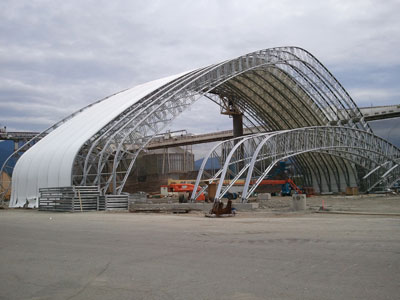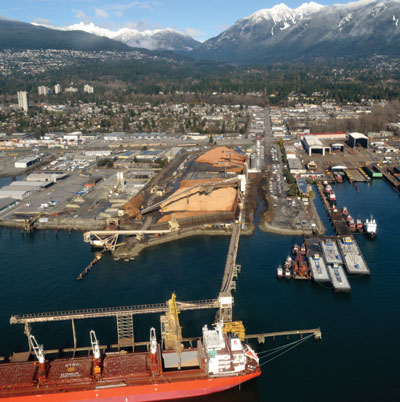
Terminal ready for jump in wood pellet production
October 31, 2011
By Jean Sorensen
Oct. 31, 2011 - British Columbia’s port terminals stand ready to accommodate a jump in wood pellet production that is expected to happen over the next five years to meet increased world demand.
British Columbia’s port terminals stand ready to accommodate a jump in wood pellet production that is expected to happen over the next five years to meet increased world demand. But it is Fibreco Export Inc. that has been leading the charge. “We have more than doubled our volume of annual exports (since Fibreco began handling pellet exports, with the first full year 2006),” says Fibreco president and CEO Grant Watkins. The company continues to expand its storage capacity at its North Vancouver facilities to meet British Columbia’s surge in pellet production.
 |
|
| Fibreco is building a new covered storage unit to keep wood pellets out of the elements until they can be loaded onto ships. Photos: Fibreco
|
The 30-year-old international wood-fibre marketing and export terminal company was originally launched by independent mills and is now a private enterprise. So far in 2011, it has handled l00% of British Columbia’s pellet exports, although its next-door neighbour, Kinder Morgan, handled some of Pinnacle Pellet’s shipments up until 2010. Pinnacle also has unused storage capacity at Port of Prince Rupert, where it has loaded ships through Ridley Terminals.
“There is tremendous expansion in demand going on worldwide and part of that expansion is being handled in British Columbia,” says Staffan Melin, a member of the University of British Columbia faculty of chemical and biological engineering and research director for the Canadian Wood Pellet Association. Strong demand in Europe, South Korea, and Japan is expected to grow, with worldwide consumption soaring to as high as 120 million tonnes/year in 2020 from today’s 12 million tonnes, much of which can be attributed to renewable energy policies.
“According to the projections, which are for enormous expansion worldwide, we will need more terminal capacity and much more production capacity,” Melin says. He adds that it’s not only terminals that will be affected; associated transportation systems will also be influenced.
“Pellets, in the future, will be traded as a commodity,” he predicts, adding that only 20% of an average tree now goes to lumber, with the rest going into products such as pulp, particle board, wood pellets, or biomass.
Scandinavian forests are privately owned and much more efficiently run, says Melin. Forest companies, in addition to producing forest products, also operate their own energy companies using waste and at the same time generating revenues from selling heat and power. In Europe, Melin says, power companies are also acquiring forestry companies so they can lock down a fibre base. “There is a lot of vertical integration going on, and this integration is increasingly international, involving also British Columbia,” he says.
Pellet clearinghouse
The increased feed stream of pellets and bioenergy chips arriving at Fibreco’s North Vancouver waterfront and deep-sea loading terminal is a reflection of the growing world demand for biomass fuels. When Fibreco first started handling wood pellets at the end of 2005, it began with six silos capable of holding 4,500 tonnes each, yielding a combined storage capability of 27,000 tonnes. It was considered the largest international terminal in Canada for shipping wood pellets. “We are now building an 18,000 tonne fibre shed so we will be able to store 45,000 tonnes of pellets on site in total,” Watkins says.
 |
|
| Wood pellets are stored in several 4,500-tonne capacity silos and then loaded onto ships via covered conveyors. The Fibreco facility also handles wood chips, which are stored in massive outdoor piles.
|
“It’s not really a shed,” says Watkins of the new facility, which was completed in summer 2011. “It’s a very large 50,000-square-foot building.” The structure is a tension fabric facility constructed by ClearSpan Fabric Structures out of the United States, which provides fabric structures for multiple purposes, including riding arenas and salt storage sheds. The new facility will allow Fibreco to store up to a full vessel load on site between ship loadings.
Continued global demand for fossil fuel alternatives and cleaner fuels is expected to drive demand for wood pellets even higher and affect Fibreco’s storage requirements in the next five years. Fibreco is currently only using 50% of its handling capacity of 3.5 million tonnes of combined fibre products (pellets, bioenergy wood chips, and pulp chips). “After that, we will have to look at redevelopment to go higher,” Watkins says.
Further Expansion
Watkins is anticipating that Fibreco will require another expansion in 2012, with a possible doubling of the current shed, hiking storage capacity to 60,000 tonnes. That’s because the next wave of pellet production in British Columbia, with new mills coming on-stream or new lines ramping up, is expected to hit in 2012. This could affect Fibreco next year with as much as 1.5 million tonnes (up from 1 million tonnes) of product arriving at its doorstep to go to markets, explains Watkins. He adds that as the industry becomes more established, an additional 1 million tonnes of pellets “could” come to the terminal facility again in the next three to five years.
Fibreco has aggressively gone after the burgeoning pellet market, says Watkins, who came to Fibreco from MGI International, where he served as president, and also spent 14 years with British Columbia timber major International Forest Products as general manager. The pellet business neatly dovetails with Fibreco’s traditional chip export market and provides a buffer to the cyclical pulp market. Watkins estimates that of the total volume of fibre that arrives at the North Vancouver terminal this year, approximately 75% will be pellets (with 5% of that being wood chips destined for the bioenergy sector in Japan to replace coal), while only 25% will be wood chips directed towards traditional pulp markets. That’s not to say that the pulp side has dropped, but it has remained flat while the bioenergy sector has soared.
“In most cases,” notes Watkins, speaking of European market buyers, “the product is going to replace coal.” There is a growing worldwide awareness of the benefits of using wood pellets, which have almost a zero net value in carbon release when burned.
Large-scale Pellet Handling
Fibreco’s modified ship loader gives it the ability to either store the pellets brought in by rail car or “hot load” directly onto a vessel. Pellets arrive via grain rail cars, which are enclosed to protect the pellets. Fibreco has a rotary dumper on site for wood chip rail cars but uses a bottom feeding conveying system to unload pellets.
As part of the learning curve in pellet handling over the past five years, the company has been an active participant in a number of studies. In 2010, the University of British Columbia’s Biomass and Bioenergy Research Group published a report titled Quality of Wood Pellets Produced in B.C. for Export,which was a result of pellet sampling over an 18-month window performed in 2007–2008 on pellets between storage and loading at the Fibreco facility. The report concluded that British Columbia’s pellets for export meet European grades and the grades set out by the Pellet Fuels Institute for the United States.
Fibreco’s facility is located in Vancouver’s scenic inner harbour and close to large population bases. As a result, it is susceptible to complaints such as dust, plus it must adhere to stringent work safety, fire, and carbon monoxide requirements. “We have done extensive amounts of work for both fire and dust abatement,” says Watkins.
Fires from explosions, dust, and overheating in silos are ongoing concerns, both at pellet plants and at terminal loading sites such as Fibreco, as well as at discharging sites overseas. Pacific BioEnergy’s pellet plant in Prince George suffered a fire in December 2010, and Armstrong Pellets (part of Pinnacle Pellets) also suffered a fire in April 2011. “There are other more dangerous materials than pellets handled in the Port of Vancouver every day through various export terminals that have the required equipment and procedures in place to operate safely and efficiently,” says Watkins. He says that the silos on the Fibreco site have thermal probes by OPI Systems Inc. that monitor constantly. The sensors and monitors are on site, and off-site data logging serves as a backup supervisory system for alarm and failure detection. If the temperature rises, automatic fans located below the silos blow cool air through to reduce the temperature. Fibreco’s safety policy also restricts smoking on site.
Cool air infused into the silos also reduces the incidence of carbon monoxide buildup in silos, which can occur with off-gassing. Fibreco’s safety regulations require that all employees who work on the conveying system at the top or in the tunnel beneath the silos carry a carbon monoxide monitor. Incidents caused by carbon monoxide buildup from off-gassing have not been a problem at the Fibreco storage facility, says Watkins.
Located next door to Fibreco is one of the world’s largest terminal operators, Kinder Morgan. Kinder Morgan assistant general manager Dave Klitch says that once the contract concluded with Pinnacle in 2010, the berth that was converted to handle wood pellets is now being used to handle canola meal pellets and peas, which are higher-value commodities. “But who knows,” he says, adding that Kinder Morgan may gain business back in the future as demand for wood pellets increases. The facility has the capacity to handle up to 1 million tonnes, but Kinder Morgan tends to pursue mainly volume business. When it first revamped a berth to handle wood pellets, it installed temperature monitors, a GreCon spark detection and extinguishing system, and spark detection equipment on the conveying belts, says Klitch.
Terminals Gain Handling Expertise
British Columbia port terminals and pellet plants are moving through a learning curve and gaining greater wood pellet handling expertise to prevent fires, off-gassing, dust, and pellet quality degradation. “There are really three problems,” says Staffan Melin, who researches many of the associated problems with wood pellet storage, handling, and shipping. They are off-gassing, self-heating, and dust control. “I think we now have got a good handle on off-gassing here after a string of serious accidents overseas. We have good WorkSafe BC training programs in place for contained space entry,” says Melin. “We have also addressed the intricate problem of off-gassing onboard large ocean vessels by introducing a safety code now in place through the International Maritime Organization (IMO), with regulations for transportation of pellets in large bulk.” Self-heating occurs from chemical oxidation of fatty acids in the pellets, thermal condensation and evaporation, and biological decomposition of the material. Temperature sensors are critical to monitor heat buildup, which can cause a fire. Dust control is still the major challenge facing all pellet mills and handling facilities. “We have a better wood pellet today that is more mechanically stable,” says Melin. Currently, handling facilities are attempting to use systems for anti-static conveyance, dust collection, and dust suppression. Airborne dust is also accumulated in covered conveyance belts, hoppers, and anti-static surfaces, eliminating layering or buildup of electrostatic charges. This reduces the likelihood of fines or dust igniting on a hot surface, from a spark, or from an electrostatic discharge. “Dust control is related to not just the handling of the pellet, but also the durability of the pellet. That in turn is related to the lignin content and the length of the wood pellet as well as the machinery used for compression of the wood to produce pellets and the temperature and moisture of the material going into the extrusion channel of the pelletizer machine,” says Melin. “Lignin content also varies from species to species.” Research and applied findings have helped facilities reduce pellet degradation. “It has been a combination of fundamental research at the University of British Columbia’s Biomass and Bioenergy Research Group and learning from experience in collaboration with Fibreco and Kinder Morgan installations,” he explains. The next phase is now focused on adding natural products to the pellet, which may strengthen it. “This is especially important for torrified pellets, as the material is very brittle,” he notes. Additives such as oils, starches, and lignins are all being considered. “Binding characteristics are very sensitive, and only 0.5% moisture may change the durability of the pellets and make them even more durable,” he says. Technical evolution at pellet plants is also ongoing. A new development, known as an electric nose, has been developed in Europe and is being experimented with in the United States and Europe, but has not yet been introduced into British Columbia, says Melin. The Swedish manufacturer Firefly is known for producing sensing devices for fire detection but has recently developed the nose, which can sniff out trace gases in the very early stages of a fire’s development. Hundreds of millions of dollars are invested annually in the pellet industry around the globe, and safety has become a major concern, prompting increased preventive design and operating practices. |
Print this page
